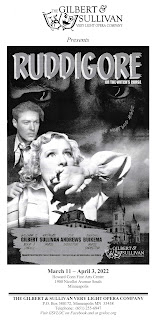The 10th of 14 comic operas from the masters of the form, Ruddigore; or, The Witch's Curse has a typically ridiculous plot of mistaken identities, star-crossed lovers, and a happy ending that comes too easily (but that's why we love them). The subject of their social commentary here is the melodrama, which director Joe Andrews has interpreted to be classic movies of the early 20th Century. He's set the story in 1948, and stuffed in so many movie references it's impossible to catch them all (but fun to try). What's the plot summary, you ask? Here goes: a troupe of "professional bridesmaids" is getting frustrated because there have been no weddings; every man in town wants to marry the sweet, beautiful, and very proper Rose (Sarah Wind Richens) but none of them has the guts to ask. Finally, a young farmer named Robin (Seth Tycon Steidl) convinces his buddy, the sailor Richard (Paul Willis, Jr.), to woo her for him. Except that upon seeing Rose, Richard instantly falls in love with her and decides to woo her himself. She agrees to marry him, until she finds out that sweet Robin wants to marry her too, and quickly switches her engagement. The trouble is, Robin is actually Sir Ruthven of the cursed Murgatroyd family, in disguise to avoid the ancient witch's curse of having to commit one crime per day. When the truth comes out (as it always does in soap operas), Rose sadly breaks her engagement and agrees to marry Richard, the one who's left, while the acting Sir Murgatroyd, Despard (Joe Allen), is now free to marry his love Margaret (Lara Trujillo), who has gone mad with despair and speaks in movie quotes. Then some ghosts arrive from all different eras (reminiscent of the CBS sitcom Ghosts) to threaten the new Baronet into being bad, until he figures out a loophole that leads to a happily ever after for everyone! Got it?
The classic movie theme is consistent from the moment you enter the theater, with period ads playing on a screen, movie theater ushers singing us the cell phone/mask rules, and filmed credits rolling before the show begins. The cast gamely imitates classic movie lines, interspersed with the original dialogue, to the delight of the audience. The period costumes (designed by Barb Portinga) are spot on and include bridesmaids' dresses that are really too lovely to be bridesmaids' dresses (with pockets!), movie usher uniforms, Rose's blond bombshell look, sailor uniforms, sharp suits, '40s era dresses, and wonderfully over-the-top ghost costumes from every conceivable era. The charming two-dimensional set pieces (designed by Larry Rostad), the village square in Act I and the Murgatroyds' grand estate in Act II, provide a nice backdrop. Penelope Freeh's choreography is sweet and funny and ably performed by the ensemble, especially impressive are the group dance numbers on the not very large stage. (Warning: there is an extended strobe light scene which I'm sure creates a cool effect, but is too much for my nervous system to handle.)
This large and talented cast sounds absolutely gorgeous in this space (unmiked), along with the full backstage orchestra (conducted by music director Randal A. Buikema). It's always amazing to me how Gilbert and Sullivan managed to marry the most ridiculously clever lyrics with such beautiful, complex, layered melodies and harmonies. A song about the seasons towards the end of Act I is a musical highlight of the show. Then when I heard the "Matter Patter" in Act II, I thought - hey that's from Pirates of Penzance! Turns out it was actually written for Ruddigore, and later put into the 1980 Shakespeare in the Park production which was made into a film in 1983 (you can watch it here performed by the brilliant trio of Angela Lansbury, Kevin Kline, and Rex Smith - go ahead, I'll wait).
As much as I enjoyed this show, I was disappointed in the lack of diversity in the casting.* In 2022, post-Hamilton and post-George Floyd, it's unacceptable to have a cast of over 30 people on stage with almost all of them white. Especially when performing at the Howard Conn Fine Arts Center in the diverse neighborhood of South Minneapolis. There's a stark difference between what the world and its people look like outside and inside the doors of the theater. GSVLOC has mastered the art of the comedic opera, now I'd like to see them expand it to be more diverse, inclusive, and representative of the world we live in.
Ruddigore; or, The Witch's Curse continues weekends through April 3. And watch for Pirates of Penzance (my personal favorite G&S, partly due to the above-mentioned movie) coming this fall.
*Note: GSVLOC has contacted me to say that they are aware of the lack of diversity, and have been and will continue to work on it. And I realize now that achieving diversity is more challenging for a community theater that doesn't have the resources of a professional theater, but it's still a worthy goal.

